Introduction
Boat building is an excellent way to get out on the water without having to deal with the hassles of renting or buying a boat. You can build your boat, for example, and take it out whenever you want. It will also save you money because you won’t have to pay for gas or maintenance costs. Boat plans are easy-to-use guides that show you how to make your dream boat come true. They provide step-by-step instructions that even beginners can follow and they include tips on how to minimize expenses while maximizing enjoyment during construction.
Design the Boat, Draw the Lines, and Choose the Material
Once you’ve determined the size of your boat, it’s time to start drawing. Your lines should be drawn with a ruler, but don’t worry about getting them perfect. Even if they’re not perfect, your handmade boat will still be fun to sail and enjoy. Once you have drawn your lines in pencil or pen on paper or cardboard (if you want), cut them out with scissors or an x-acto knife so that they can be used as templates when building your boat. When choosing a material for building your boat, try using something like chipboard, foamboard, corrugated cardboard, or even wood scraps from other projects around the house. You could also use some thick paper towels rolled up into tubes which are then taped together with masking tape until they become rigid enough to stand up straight without collapsing onto themselves (this method works best when making really small boats).
How to find a good boat mechanic.
Next, finding a good boat mechanic like these boat builders in NZ is to know the type of boat you are building. There are many different types of boats, and each one requires different skills from the people who maintain them. Some boats require more mechanical knowledge than others, while some boats require more electrical knowledge than others. You should know what type of boat you have before looking for a boat mechanic that can help with your project.
The next step after knowing which type of boat you have is knowing what kind or types of repairs need to be done on it. You may only need small touch-ups such as fixing minor dents or scratches in paintwork, but at other times larger repairs may be required such as replacing an engine or fixing holes in the hull due to corrosion or wear-and-tear over time while out at sea (or just sitting at home). If there aren’t any major problems with your vessel’s structure already then it may not be worth hiring someone else because they won’t necessarily know how best to approach certain situations when they arise later down the road and save yourself money by doing everything yourself.
A look at painting your boat.
Painting a boat isn’t as difficult as it might seem. It can be an enjoyable and relaxing activity that even kids can help with. If you have never painted a boat before, keep in mind that learning how to paint from boat painters is just like learning any other new skill and it takes time and practice. Here are some tips on how to paint your boat:
- Use the right kind of brush. When using a paintbrush, choose synthetic bristles instead of natural ones because they will last longer and give you better coverage throughout painting multiple coats on your vessel. Also, make sure that both ends are shaped properly so that you don’t accidentally scratch or damage adjacent surfaces as you apply coats over them (i.e., if one end is flat and wide while another end has more pointed tips).
- Clean up any residue from previous coats before applying another one; this will help prevent peeling later on down the road after several layers have been added to each other. Apply several thin layers rather than one thick one; this ensures smoother texture overall with fewer chances for runs or drips along edges where two colors meet head-on (which may cause unsightly stains).
Tips on how to build a remote control ship.
Whether you’re a beginner or an expert, here are some tips on how to build a remote control ship.
- Start with the right plans and materials. With any engineering project, it’s important to have high-quality plans and parts to ensure your project runs smoothly. Look for remote-control boat kits online or at retail stores.
- Build the frame first. Be sure that all pieces fit together properly before adding any additional components such as motors and propellers; otherwise, you could run into issues later on during the assembly or operation of your finished boat.
- Mount an electric motor near the center of both sides of your boat’s hulls (or bottoms) so that it can move both left and right when operated by its controller(s). Use strong glue such as epoxy adhesive for these connections between motors/propellers, batteries/chargers, etc., not only will this make sure everything stays put but also keep things quiet while in use.
Boat building is an art form.
Boat building is an art form. It takes time to learn, but it’s worth it. In addition to learning the skills necessary for boat building, you will also be able to express yourself in this creative way and get out into nature. You’ll gain insights into the environment by studying how nature can operate with limited resources such as wood or fiberglass and how these materials work when put together in a boat shape. Boat building is both a skill and an art form. To learn how to build boats, you must first learn the basics of boat building. This includes learning how to construct the hull, deck, and transom (the stern part) of your vessel, as well as other parts like masts, rudders, and keels. Boat building can be challenging at times but with time and patience, it will all come together nicely.
After getting started with boat plans that are suitable for your skill level you need some basic tools that are essential in any project:
- Tape measure
- Sharpie marker
- Pencils/erasers
Conclusion
Boat building is a very rewarding hobby. You can build a boat that will last for many years and be able to enjoy it with your family and friends. The best part about building a boat is that there are no limits to what you can do with it. Build it any way you like.




